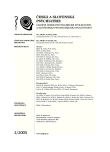Contribution to the Discussion about Dissociative States, Taking into Consideration the Work of Pierre Janet (1859 – 1947)
Příspěvek k diskusi o problematice disociativních stavů s přihlédnutím k dílu Pierra Janeta (1859 – 1947)
V první řadě je věnována pozornost pohledu Pierra Janeta na problematiku disociací, především na historické kořeny jeho konceptu. Z Janetových prací jsou citovány pasáže z děl jeho předchůdců, které on považuje za esenciální. Jde o historickou práci J. J. Moreau (de Tours) „O hašiši a mentálním odcizení“ z roku 1845, odkud pocházejí pojmy „mentální degradace“ a „fixních idejí“. Dále jde o anonymní práci z roku 1855, podepsanou „Hloupým Honzou“, ve které jsou brilantně zobrazeny základy disociativní teorie. Je citován Janetův kritický pohled na freudiánskou psychoanalýzu, ve kterém Janet popisuje, jak se Sigmund Freud zmocnil jeho myšlenek a konceptů, aniž by jej citoval. Dále jsou zmíněny postoje nizozemských terapeutů k neodisociativní Hilgardově teorii, především ke konceptu „skrytého pozorovatele“, jenž se dělí do tří skupin: akceptace, tolerance a odmítání. Je načrtnut rozdíl mezi koncepty vertikální a horizontální disociace. Též je věnována pozornost instrumentům na měření disociativních poruch v Nizozemsku: DES, SCID-D a především DIS-Q, což je dotazník vyvinutý a validizovaný v Nizozemsku a Flandrech.
Klíčová slova:
Pierre Janet, J. J. Moreau (de Tours), S. Freud, disociace, „skrytý pozorovatel“.
Authors:
J. M. Nerad 1; L. Neradová 2
Authors‘ workplace:
Stichting Centrum 45, Oegstgeest, Nizozemsko
; ředitel drs. J. W. Reerds, MBA
Psychiatrická poliklinika Mentrum, Amsterdam, Nizozemsko
1; ředitel drs. W. Mulder
2
Published in:
Čes. a slov. Psychiat., 101, 2005, No. 2, pp. 98-104.
Category:
Comprehensive Reports
Overview
In the first instance is the attention payed to the ideas of Pierre Janet about dissociation, especially to the historical roots of his theory. There are quoted passages from Janet’s works concerning two historical books which he considers essential for his own dissociative theory. The first one is the work of J. J. Moreau (de Tours) “About Hashish and Mental Alienation” from 1845. J. J. Moreau (de Tours) was not only the member of the famous “Club of Hashishins” in Paris, he was also provider of hashish: introducing this drug to the Pleiad of French artists between 1840 and 1850 and using it for therapeutic purposes in the psychiatry. J. J. Moreau earned the nickname “Father of the modern psychopharmacology”. He was also the first one using the terms “mental dissolution” (désagregation psychologique) and “idées fixes”. The second important source of Janet’s dissociative theory is a completely unknown booklet by an anonymous called Gros Jean (Simple Simon) from 1855. This author describes “division of personality” with amnesia between the two states. Janet also passes criticism on Sigmund Freud, showing how Freud adopted his ideas without quoting him and in addition criticizing Freud’s pansexualism. From Pierre Janet there is only a small step to the neodissociative theory of Hilgard. The attitudes of Dutch therapists concerning the idea of “hidden observer” can be classified in three categories: acceptance, tolerance or rejection.
It is in Hilgard’s belief that hidden observer concerns vertical dissociation contrasting horizontal dissociation. Among the instruments for the measurement of dissociative disorders there is a very interesting “Dissociation Questionaire” (DIS-Q), developed and validated by Vanderlinden and collaborators in the Flemish part of Belgium and in The Netherlands in the first half of the nineties.
Key words:
Pierre Janet, J. J. Moreau (de Tours), S. Freud, dissociations, “hidden observer”.
Labels
Addictology Paediatric psychiatry PsychiatryArticle was published in
Czech and Slovak Psychiatry

2005 Issue 2
- Memantine in Dementia Therapy – Current Findings and Possible Future Applications
- Hope Awakens with Early Diagnosis of Parkinson's Disease Based on Skin Odor
- Memantine Eases Daily Life for Patients and Caregivers
- Deep stimulation of the globus pallidus improved clinical symptoms in a patient with refractory parkinsonism and genetic mutation
Most read in this issue
- Safety and Tolerability of Second and Third Generation Antipsychotics
- Prediction of Efficacy of Inpatient Treatment in Metamphetamine Dependence
- Psychosocial Stressors in Young Families from Brno and Znojmo Part II
- Pesso Boyden Psychomotor Therapy in the Treatment of Traumatized in Patients, Survivors of Second World War in the Former Dutch East Indies
